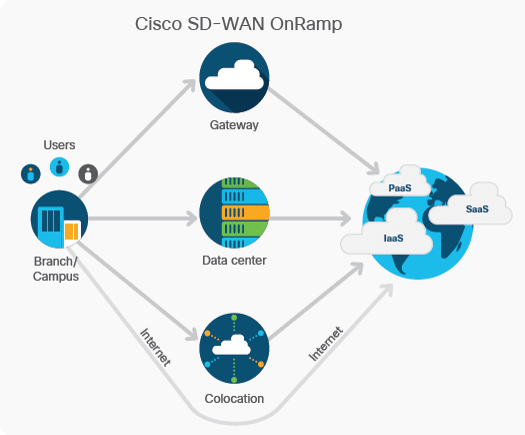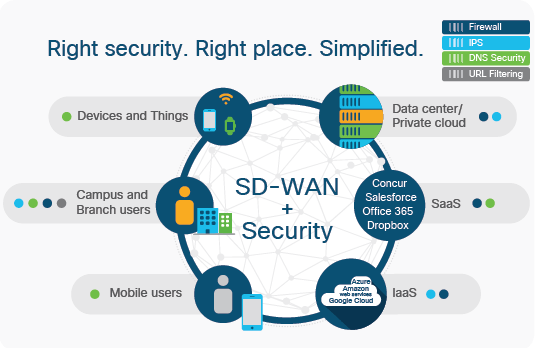Cisco SD-WAN Viptela Overview
Cisco SD-WAN is a WAN Solution which enables digital and cloud transformation for Enterprise. It uses all the routing, Security, along with Centralized policy with orchestration facility for large and medium scale networks. This Course will help you to prepare for Implementating Cisco SD-WAN Solution ENSDWI v2.0 exams. This course is rated as best Implementing Cisco SD-WAN Solution ENSDWI v2.0 Training.
In this Cisco SDWAN Viptela Training you will learn Cisco SD-WAN Viptela concepts and will make you learn how to Configure Cisco Viptela components and its features via implementing Cisco SD-WAN Solution ENSDWI v2.0 labs section.
There are some summery benefits and need to understand why we deploy SD-WAN Solutions:
- Cisco SD-WAN is multi-tenant, Cloud Delivered, secure, automated and application aware solution used for WAN environment.
- Cisco SD-WAN provides centralized management and policy management which helps in reducing change control and deployment times
- Cisco SD-WAN is a WAN independent solution and uses mix of MPLS and low cost broadband or any combination of transport in active/active method
- It is transport independent overlay that can be used to extend the Data center, any branch and cloud
- It has a separate Control plane and data plane, due to which controller ( which handles control plane ) can be deployed on premises or in cloud or combination of either and vEDGE ( which handles data plane ) can be used as physical or virtual can also be deployed anywhere in cloud
- It provides deep end security by encrypting data from source to destination or we can say that from end to end network. All the devices in SD-WAN uses certificate to trust each other which protect control plane, provides firewall for application,
- SD-WAN solution can also be integrated with Cisco Firewalls along with other network Services
- It not only provides application-aware policies with real time service level agreement enforcement but also provides application visibility and recognition
- For SaaS application, it does dynamic Optimization which further results in improvement of application performance.
- Full Cisco SD-WAN Viptela labs Scenerios (Implementating Cisco SD-WAN Solution ENSDWI v2.0 labs) ,Task & Solutions along with Cisco SD-WAN Viptela Training Materials.
There are some unique feature and benefits for SD-WAN solution
Cloud First Architecture:
Cisco SD-WAN solution provides connectivity across Enterprise WAN from Single Console or dashboard to connect Cloud Platform as well as Data Center and branch providing greater Speed, reliability and efficiency.

Via Cisco SD-WAN vManage Console, a virtual private gateway can be deployed in infrastructure-as-service (IaaS), PaaS environment by automation.
With vManage dashboard, it monitors underlay performance and thus automatically selects the fastest and most reliable path to reach to Cloud applications or anywhere they are located.
Robust Security:
Cisco SD-WAN solution uses Certificate based trustworthy platform which provides right security in right place.
With Cisco vManage Single dashboard, all network can be hardened, which further reduces risk, and ensures business compliance, continuity and Security.

With Cisco SD-WAN solution, routers in WAN can be transformed in multilayer security device, with an application-aware enterprise firewall, IPS, URL filtering with continuous DNS monitoring.
It can also segments end to end network traffic, which protects business against data exfiltration and insider threats.
SD-WAN advance analytics dashboard:
With vManage advance analytics dashboard engine it provides following:
- End to end application visibility and infrastructure visibility across fabric
- It provides real time information for application performance and also forecast application performance
- It provides assistance in application provisioning, bandwidth increases and branch extension
- Helps is deployment of templates based policies and its preferences
To achieve predictable performance, it also provides application QoS categorization and policy changes

Al these above features we will see in how to configure Cisco Viptela Components section or Configure Cisco Viptela labs which prepare for Implementating Cisco SD-WAN Solution ENSDWI v2.0 Exams.
Note: ( Refer before Purchase )
- We don't offer Any Hands-On labs for practice in this course.
- Cisco Viptela Lab discussed here contains different Scenarios, task & Its recorded Solutions.
- Conent of each page is 30-40% visible for Customer verification about content.
- Before any purchase , verify content then proceed,VLT is in progress,No refund Policy.
- For More Detail : Mail dclessons@dclessons.com , FAQ & TC page.
- You can get Sandbox lab access from Cisco , details and its access information is available in SDWAN Sandbox Labs Section for Basic lab configuration only.
GENERAL FAQ
Cisco SD-WAN is a software-defined networking (SDN) approach applied to wide area networks (WANs). It uses software to control and manage the WAN, rather than relying solely on hardware, allowing for more flexibility, efficient resource allocation, and optimized application performance.
Here's how Cisco SD-WAN improves WAN connectivity and performance:
1. Enhanced Performance and Scalability:
-
Prioritized traffic:
SD-WAN can prioritize traffic based on application type, ensuring critical applications like VoIP or video conferencing get the bandwidth they need.
-
Dynamic path selection:
It can dynamically select the best path for traffic based on network conditions, avoiding congested or slow links.
-
Application-aware optimization:
SD-WAN can optimize traffic flow for specific applications, improving their performance and user experience.
2. Improved Cost Optimization:
-
Flexibility in transport:
SD-WAN allows organizations to use a variety of transport mediums like MPLS, internet, or 4G/5G, potentially reducing costs.
-
Resource utilization:
It enables better utilization of existing WAN resources by optimizing traffic flow and dynamically allocating bandwidth.
-
Reduced complexity:
SD-WAN simplifies WAN management, allowing for faster deployment and potentially lower operational costs.
-
Centralized security policy:
SD-WAN can enforce security policies across the WAN, providing a consistent security posture.
-
Integrated security features:
It can integrate with other Cisco security solutions to provide robust protection against threats.
-
Secure tunnels:
SD-WAN uses IPsec tunnels to encrypt traffic, ensuring secure communication across the WAN.
4. Simplified Management:
-
Centralized management:
SD-WAN provides a single pane of glass for managing the WAN, simplifying configuration and monitoring.
-
Automation:
It can automate tasks like device deployment and configuration, reducing manual effort.
-
Predictive analytics:
SD-WAN provides advanced analytics and monitoring, allowing for proactive troubleshooting and network optimization.
5. Multi-Cloud Optimization:
-
Seamless cloud connectivity:
SD-WAN can easily connect to multiple cloud providers, optimizing performance for SaaS applications.
-
SaaS optimization:
It can optimize traffic for SaaS applications like Microsoft Office 365 and Salesforce.
-
Cloud-based management:
SD-WAN can be managed from the cloud, providing flexibility and scalability.
In essence, Cisco SD-WAN transforms the traditional WAN by leveraging software to optimize performance, reduce costs, improve security, and simplify management.
Cisco SD-WAN ensures network security through a layered approach, including on-premises and cloud-based security features, built-in security functions, and integrated security protocols like IPsec and TLS. It also utilizes tools like firewalls, intrusion prevention systems, and web security to protect against internal and external threats.
Here's a more detailed breakdown:
1. Integrated Security Features:
-
On-premises security:
Cisco SD-WAN provides robust security at the network edge, including next-generation firewalls (NGFWs), intrusion prevention systems (IPS), and application control features.
-
Cloud-based security:
Cisco's SD-WAN solutions also offer cloud-based security features like malware sandboxing, URL filtering, and SSL/TLS decryption to protect against various threats.
-
Integrated Security Functions:
SD-WAN solutions integrate security functions like firewall, IPS, and AMP within the router's firmware, eliminating the need for separate dedicated hardware appliances.
-
IPsec:
Cisco SD-WAN uses IPsec encryption to secure traffic between locations through a secure tunnel, ensuring data integrity and confidentiality.
-
TLS/DTLS:
These protocols are used for authentication and ensuring data integrity, including the control plane traffic.
3. Threat Protection Measures:
- Intrusion Prevention System (IPS): The IPS engine uses snort signatures and Cisco Talos intelligence to detect and prevent network attacks.
- Malware Protection: Malware sandboxing helps to detect and prevent malicious files.
- URL Filtering: URL filtering protects against malicious websites and web-based threats.
- Web Security: SD-WAN solutions often include web security features like secure web gateway and DNS-layer security.
4. Network Segmentation and Access Control:
-
Network Segmentation:
SD-WAN enables network segmentation, allowing for the creation of isolated network zones to improve security and control access to sensitive data.
-
App Controls:
App controls allow administrators to manage and control access to various applications.
5. Authentication and Trust:
-
Whitelisting:
Cisco SD-WAN uses a whitelisting model, requiring devices to be pre-approved before joining the network.
-
Certificate-based Authentication:
Devices authenticate using digital certificates to ensure that they are trusted and not imposters.
Cisco SD-WAN leverages four key components: vManage (Management Plane), vSmart (Control Plane), vBond (Orchestration Plane), and vEdge (Data Plane). These planes work together to manage and optimize network traffic across multiple WAN links, providing a centralized and flexible network infrastructure.
1. vManage (Management Plane):
-
Function:
Provides centralized management, monitoring, and policy configuration for the entire SD-WAN network.
-
Example:
vManage enables administrators to view network performance metrics, configure policies, and deploy new devices or applications across the SD-WAN.
2. vSmart (Control Plane):
-
Function:
Responsible for building and maintaining the network topology, making decisions about traffic flow, and applying routing policies.
-
Example:
vSmart controllers analyze network conditions and use dynamic routing protocols to select the best path for data transmission.
3. vBond (Orchestration Plane):
-
Function:
Facilitates the automatic onboarding and management of SD-WAN routers, ensuring they are correctly integrated into the network.
-
Example:
vBond streamlines the deployment process, allowing new branch offices to be connected to the SD-WAN network quickly and easily.
-
Function:
Handles the actual forwarding of data packets based on instructions from the control plane.
-
Example:
vEdge devices act as the physical or virtual gateways at each branch location, forwarding traffic across the SD-WAN overlay.
In essence, these four components work in a coordinated manner:
- vManage manages the network, vSmart controls the traffic, vBond orchestrates the deployment, and vEdge carries the actual data.
- This separation of duties allows for a highly flexible and scalable network infrastructure, enabling businesses to optimize their WAN connections and improve application performance.
- Cisco SD-WAN also includes features like application-aware routing, secure tunnels, and cloud integration to enhance network performance and security.
- We don't offer Any Hands-On labs for practice in this course.
- Lab discussed here contains different Scenarios, task & Its recorded Solutions.
- Content of each page is 30-40% visible for Customer verification about content.







LEAVE A COMMENT
Please login here to comment.